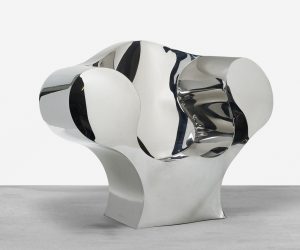
Ron Arad (Israeli, b. 1951), “Big Easy Volume 2” chair, 1988, Polished stainless steel, Edition 11/20, Museum purchase, William McDonald Boles and Eva Carol Boles Fund, 2016.54
Ron Arad is one of the most influential designers of our time, known for his daring forms that span the disciplines of furniture, sculpture, and architecture. When the Museum of Modern Art mounted a 2009 retrospective of the Israeli-born designer, they summed up Arad as having been “imitated, idolized, feverishly discussed, and criticized, but never ignored.” Arad’s 1988 Big Easy Volume 2 was among the first pieces of contemporary design added to NOMA’s decorative arts collection.
This shape of this exaggerated, cartoonish chair suggests comfort, but its hard edges and steel body appear in contrast to its voluptuous curves. This hollow, large-volume shape is one of the artist’s signature forms. Iterations of this design chart Arad’s evolution from countercultural young designer to design superstar with a mass-production studio.
Ron Arad left Tel Aviv for London in the early 1970s. In the early 1980s the young maverick operated One Off, a gallery-studio that specialized in bricolage design with rough edges, exposed welding, salvaged materials, and splashes of paint. Arad’s furniture was the physical embodiment of punk culture—design set to the tune of The Sex Pistols and The Clash.
It was in that context that Arad made the first version of this chair in 1988. This prototype was made of welded rugged steel, but was soon followed by a production of twenty in smoother stainless steel of which NOMA’s chair is #11. Arad said of his work: “The first of the chairs said to you ‘look I am crude, that’s who I am.’ … with experience, the welding got better, the technique got better, and if the first ones were about crudeness, the next ones were about being refined.” Arad named the chair “Big Easy,” self referencing an earlier series of chairs he’d named “New Orleans.”
The Big Easy shape had staying power in Arad’s production over the next thirty years, with editions made in fiberglass and upholstered with foam. The form is a powerful statement on volume and illusion, and like the best of Arad’s design, it fully blurs the distinction between furniture and sculpture. The Big Easy is an outstanding example of how one designer can successfully rework designs through a career, turning to different materials, processes, and even attitudes to fully explore an idea.
Mel Buchanan, RosaMary Curator of Decorative Arts and Design